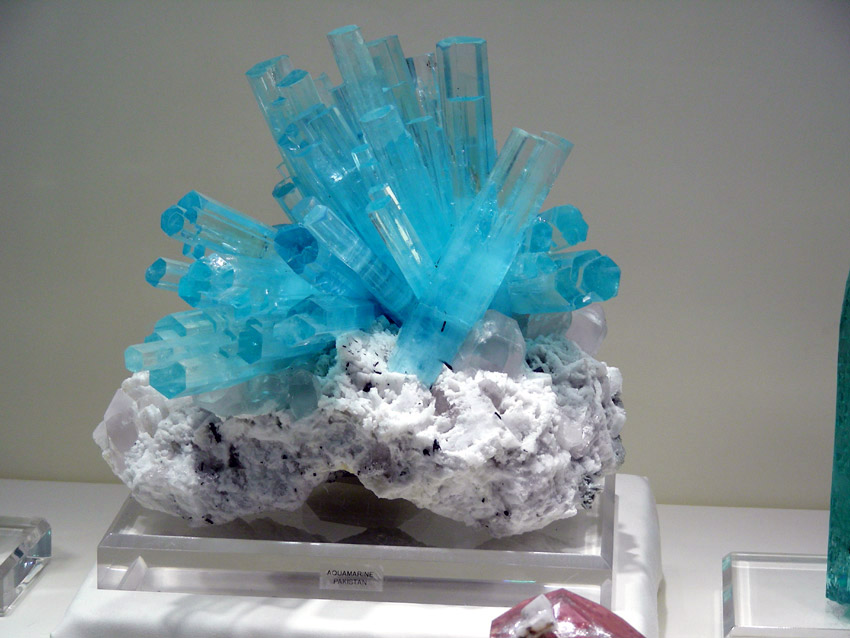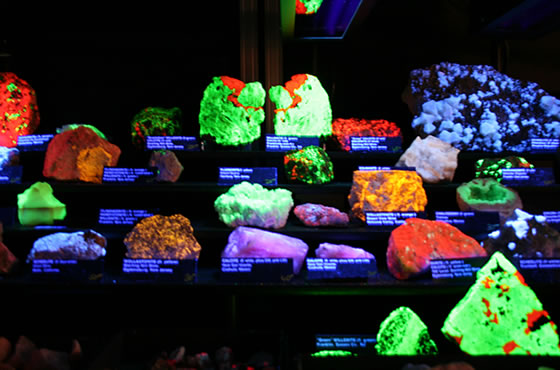Ok I think its time to reveal one of my recent ideas for adding a new dimension to the hobby. I'm sure its not completely new...lots of people have probably thrown a unique rock, mineral specimen or something into a viv because it was pretty. What I'm talking about here is taking it further...using the idea as a major foundation for the design, and opening up a discussion about it. My knowledge of geology is limited though I do have some...I know not all minerals will be suitable for our purposes due to the potential for changing ph, or adding minerals to the soil that would be harmful to plants or animals, maybe even giving off radiation. I don't recommend anyone throw some chunks of uranium-238 into their viv. Though some decorative uranium enriched glass may be ok since if I remember correctly it only gives off radiation within the range of normal background radiation (Could be mistaken).
Well that leads me to another aspect of this idea, Fluorescence. Many of you may not be aware of this but many minerals fluoresce under various wave lengths of UV light. Short wave UV would be far to dangerous to safely employ in a viv and may rule out some minerals at least to get the colors we want from them...but others fluoresce under medium/long wave uv lights like the more typical novelty black light which I have seen sources that say they put out uv wavelengths similar to about what a typical uv reptile bulb does and should be relatively safe to plants and animals. Especially if only on for a short time so they are less likely to damage vision or other wise stress a plant or animal. Below I will post a few pics of some of the minerals I've been considering and some pictures of minerals under UV light and let your imaginations do the rest of the work I have already ordered my first slab of labradorite btw...
I have already ordered my first slab of labradorite btw...
Well start with that one...
![Image]()
![Image]()
![Image]()
![Image]()
![Image]()
![Image]()
![Image]()
![Image]()
![Image]()
Ok that as just a few unlabeled examples to get the imagination working. Here are some examples of mineral fluorescence...
![Image]()
![Image]()
![Image]()
Ok I got kind of lazy using the group shots there, but hopefully you can see the potential here. One issue is cost...Many specimens can be very expensive but I've been shopping around and looking on ebay and I've seen a lot of stuff that is affordable, of large enough size and could be used very creatively. I would like it if people could share possible concerns and safety issues and offer up examples of specific minerals that might be worth a try or ones we should definitely rule out. I personally plan to scape a viv using labradorite, and also do a mixed mineral fluorescent viv utilizing long wave black lights for a short time before all the lights go off at night. Ok kids let your imaginations run wild...and feel free to post the results or any examples where you or someone else has already done something like this.
Well that leads me to another aspect of this idea, Fluorescence. Many of you may not be aware of this but many minerals fluoresce under various wave lengths of UV light. Short wave UV would be far to dangerous to safely employ in a viv and may rule out some minerals at least to get the colors we want from them...but others fluoresce under medium/long wave uv lights like the more typical novelty black light which I have seen sources that say they put out uv wavelengths similar to about what a typical uv reptile bulb does and should be relatively safe to plants and animals. Especially if only on for a short time so they are less likely to damage vision or other wise stress a plant or animal. Below I will post a few pics of some of the minerals I've been considering and some pictures of minerals under UV light and let your imaginations do the rest of the work
Well start with that one...









Ok that as just a few unlabeled examples to get the imagination working. Here are some examples of mineral fluorescence...



Ok I got kind of lazy using the group shots there, but hopefully you can see the potential here. One issue is cost...Many specimens can be very expensive but I've been shopping around and looking on ebay and I've seen a lot of stuff that is affordable, of large enough size and could be used very creatively. I would like it if people could share possible concerns and safety issues and offer up examples of specific minerals that might be worth a try or ones we should definitely rule out. I personally plan to scape a viv using labradorite, and also do a mixed mineral fluorescent viv utilizing long wave black lights for a short time before all the lights go off at night. Ok kids let your imaginations run wild...and feel free to post the results or any examples where you or someone else has already done something like this.




